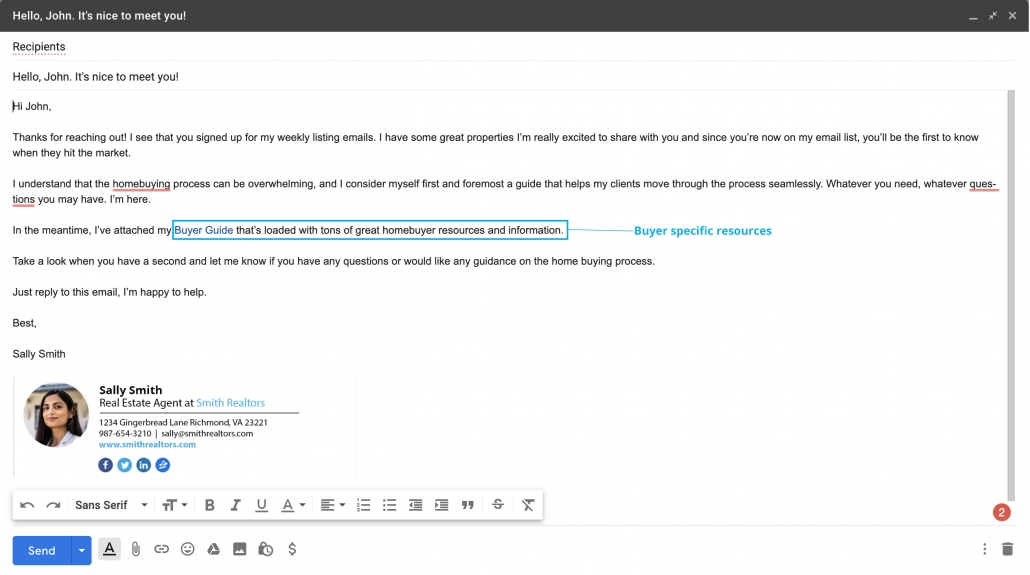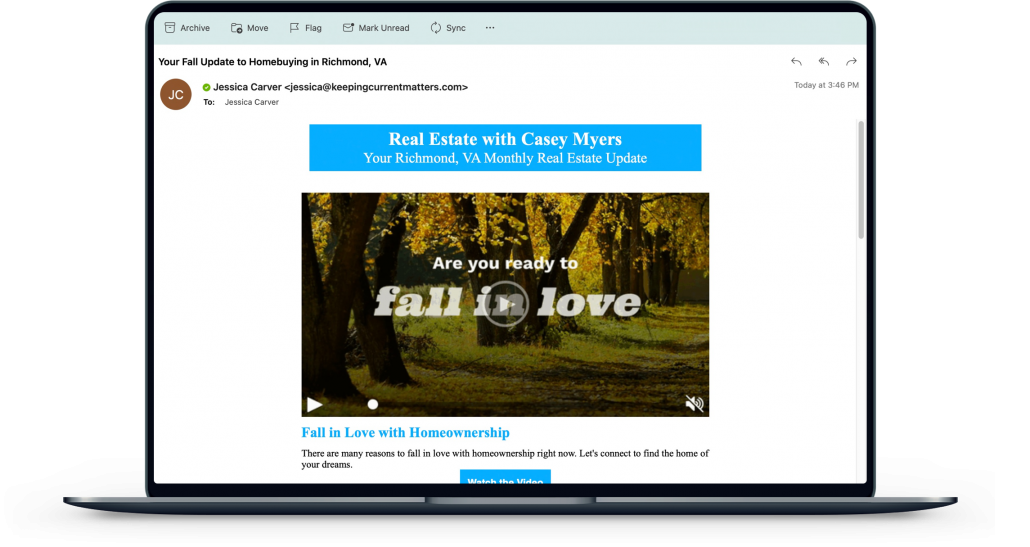Failproof Tips for Improving Your Lead Follow-Up (with Free Examples)
Do you ever find yourself hitting a stretch of bad leads?
It’s the nature of the game. You can’t win them all, right? And maybe your marketing efforts really are bringing in nothing but duds and dead ends.
Or maybe, it’s not your leads that have gotten stale but rather your lead follow-up.
Check out our tips for creating email drip campaigns that turn more leads into listings.
What Is a Real Estate Drip Campaign?
If you’re still sending out individual email blasts to your clients, we have news: there’s a better, easier and faster way to nurture those relationships.
By using an email marketing platform or CRM (think MailChimp), you can set up automatic drip campaigns for every type of lead at every stage of the process.
Good lead nurturing emails get 4-10 times the response rate compared to standalone email blasts. They don’t feel salesy, are personalized, and help nurture the growth and development of the relationship. Most importantly, they convert.
Ideas for Your Email Drip Campaigns
But before we dive in, ask yourself a couple of things:
- Does your marketing stand out from your competition?
- Do you have an actual lead follow-up strategy?
- Are you really doing everything you can to convert those leads into happy clients?
If you answered no to any of these questions, it’s probably time to re-think your email strategy.
Here are some tips plus examples of how to get your lead follow-up strategy to turn contacts into clients.
Make It Personal
The first step to peaking a leads interest is by showing that you’re an actual human being. To do this, your emails should be friendly yet professional and reflect your personality.
Your readers will be turned off by a stale sales pitch, so take some time to write something that sounds like a real person wrote it. If you hit a bit of writer’s block, try recording different messaging on your smartphone and then transcribe it.
Good writing will take you far but personalization will take you further. According to Mailgen, email personalization can increase open rates by 39% and drive 18 times more revenue than general broadcast emails.
Take a look at this example:
The same goes for how your emails look. Contrary to popular belief, overly designed emails can come off as impersonal and have a higher chance of ending up in a spam box. Keep it simple, friendly and personalized to improve your lead nurture.
And remember, your emails should look and sound like you’re writing to a friend, not a client. Taking the time to craft something great is well worth the extra effort because emails are one of your best tools for building relationships with clients. Plus, first impressions count!
Educate With Your Emails
Education is the key to establishing authority and building trust so you stand out as someone who cares-not just another real estate agent.
Think about this: the average agent is constantly sending emails just trying to make the sale. But you are different. You know the secret to better email engagement, and you’re sending out emails with helpful insights that offer value and aren’t annoying, desperate or overbearing.
So how do you provide value? You use content that answers their questions and puts their needs into your hands. KCM content can act as an incredible asset for agents who want to do more than just the minimum. Check out how we did it below.
When you consistently deliver value to your list, over and over again – for FREE – you are driving home the point that you’re the leading expert. You are the only agent they should ever consider working with.
Do this, and you’ll begin standing out as the trusted advisor potential clients are looking for.
Don’t Send Every Lead Every Email
If you really want your emails to be effective, segmentation is an important step.
In short, segmentation means you split up your database into different types of leads at different stages of the sales process. In order to create a winning strategy for lead nurture, the information you send to a potential seller should be different than what you’d send to a first-time homebuyer, for instance.
This is a common mistake made by many different agents, but you don’t have to.
In your database, start tagging names in your list with descriptive categories so you can do your best to send content specific to their needs.
Then as you plan an email message, you can look at your content and ask yourself, “What audience does this post/graphic/guide best suit?” That will help you determine who to send it to. Here are three simple ways you can segment your list:
- Prospective buyers
- Prospective sellers
- Past/closed buyer clients
This is just a good place to start. You could go even deeper with more specifics like first-time homebuyers, free home valuation leads, open house sign-ups, etc. When it comes to segmentation, more is never too much. See a great way of how we did this below.
The beauty of this strategy is simple. If you send different groups exactly what they want to know and don’t send them things they don’t need to know:
- They are much more likely to open your emails.
- You build tremendous trust because they aren’t getting emails that are irrelevant to them.
- Your chances of getting the appointment increase tremendously because you are directly addressing their specific needs or questions.
For the examples above, here are three articles you could send to those different groups today:
Prospective buyers: The Many Non-Financial Benefits of Homeownership
Prospective sellers: Home Prices Are Not Falling
Past/closed buyer clients: Homeowners Have a Lot of Equity Right Now
You can even view KCM Blog content by category to easily find relevant materials for each segment of your email list.
Create Emails Around ONE Pain Point
The real estate process can be an incredibly overwhelming experience for the average person. That’s why solving problems helps your clients understand why they should consider you (and only you) for the job. If it were a movie, the home buying/selling process is the villain and you’re the hero coming in to save your clients from all (or most of) the stress.
The problem is the WHOLE story, and it’s why people pay attention. If you aren’t solving problems, then you are sending junk mail. If you aren’t saying something different, then you are saying the same as all the other agents. By choosing a pain point or problem you know your email list has, you can craft an email that provides the answer or offers a resource that gives them a solution.
If you try to take on too much in your messaging, the intention can get lost in the words. Stick with one clear directive, and your sales journey becomes easier to navigate. Sometimes when we are given too many choices, we’re unable to see the one thing we need.
Remember, you’re not an agent. You’re a friend who also happens to be a real estate agent. When you write with a singular problem or pain point in mind, and guide them to the answer to all their real estate problems: you.
Be the guide that helps your clients win the day in every email you send.
A few common problems you can help your prospects and clients solve are:
- They are hesitant to buy because mortgage rates are high right now.
Solution: Mortgage Rates: Past, Present, and Possible Future
- They need to get pre-approved before they can see a house but don’t realize this yet.
Solution: Beginning with Pre-Approval
- A seller needs to get the most money for their house so they can afford their dream home.
Solution: Why It’s Still a Seller’s Market Today
Email Your List Consistently
Many agents are afraid of emailing their list too often, but the opposite (not emailing enough) can sometimes be even worse. You don’t want to be annoying but you also don’t want to be forgotten. Luckily, marketers have found a sweet spot.
Ideally, you’ll want to email your list once a week or once every other week. For consistency, it’s best to pick a specific day, like Mondays, to send your emails.
At a bare minimum, you need to email your list once per month. Any less than that and the likelihood of your subscribers selling a home with you becomes very slim. Whatever you do, don’t send more than two emails a week.
Your communications reflect on your business. With regular communication, you can demonstrate that you are a trustworthy partner who always delivers. – Evolved Office
As with most things in life, the quality of your email content and not the quantity is what matters. You can send fewer emails full of helpful information and resources, and have a greater chance of a conversion. This will also build trust in your audience, letting them see you aren’t always just trying to get their business, you’re here to help.
On the flip side, it is okay to give a gentle call to action in every email asking for some sort of engagement. Just don’t make the entire email a sales letter. Give value more than anything else.
Bottom Line
Case and point: if you consistently provide helpful, relevant content to your email list, you’ll nurture and build your relationships over time. This will lead to better conversation rates on your database and closing more deals each year.
KCM makes this easy with the Email Builder feature, the simplest way to create professional emails and newsletters in seconds. Just pick and choose the KCM content you want to include and then copy and paste it into your CRM. It’s really that easy.
Imagine how your audience will view you compared to the competition. You will be the one sending them helpful content that matters specifically to them.
Sign up for a 14-day free trial of KCM and start creating great email drip campaigns today.









